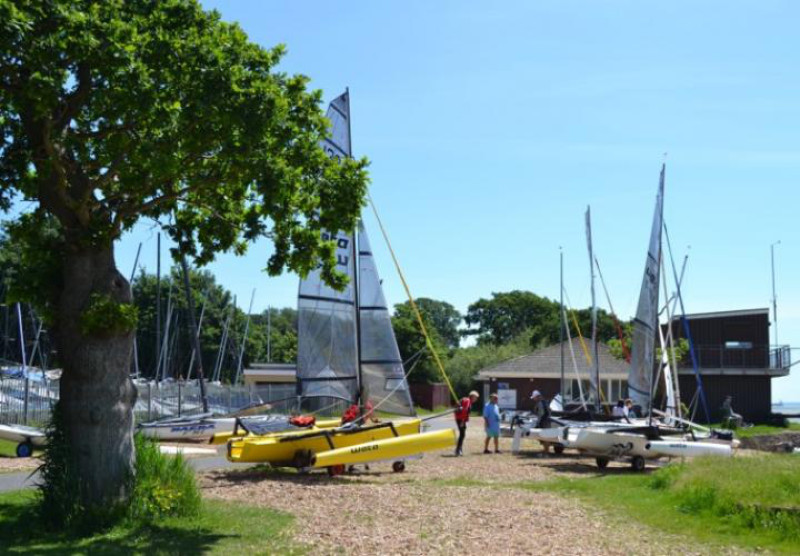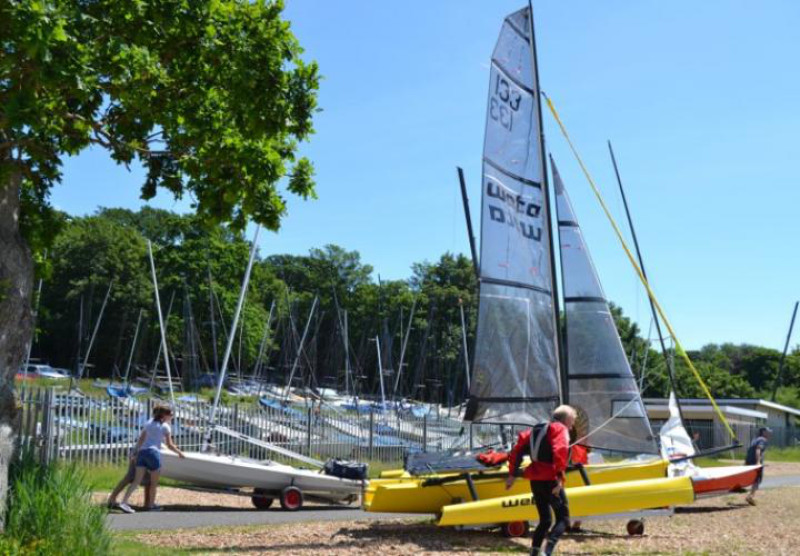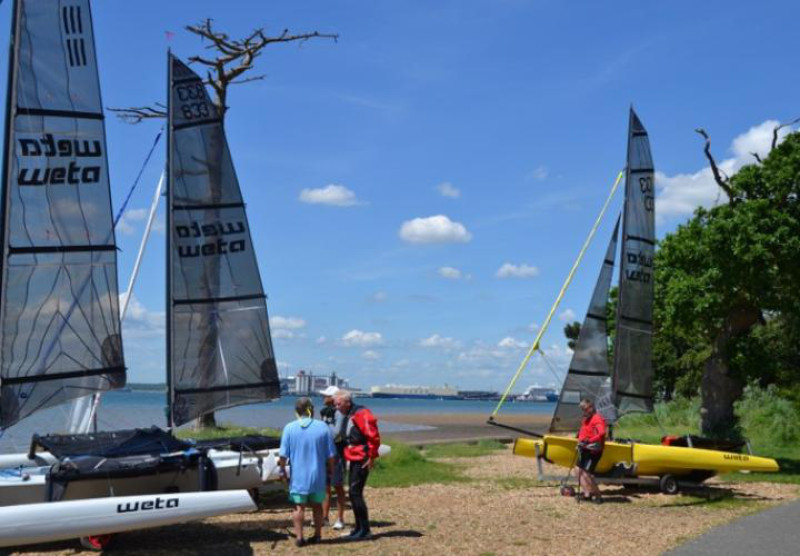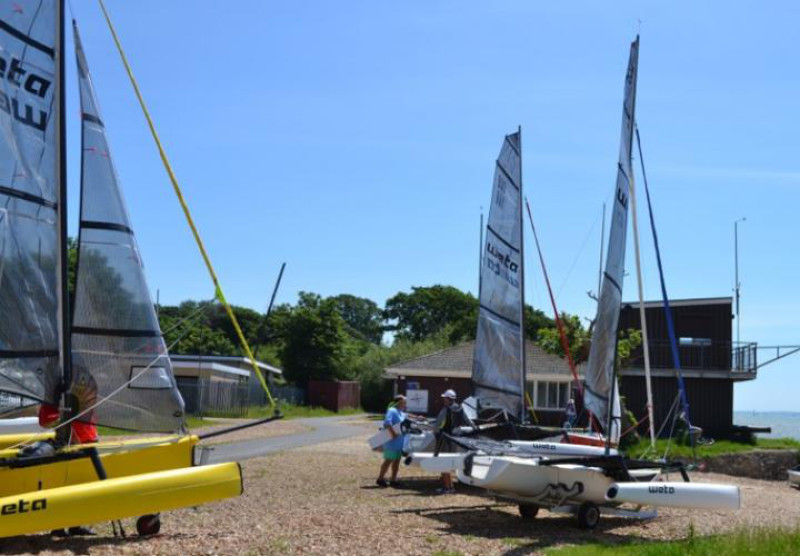
June 11th, 2018
The Weta Class Association put on a Weta swarm at Weston Sailing Club on w/e 2nd and 3rd June 2018.
The following is John Fairclough’s ‘How to win’, so read on!
A total of eight Wetas competed in two races at WestonSC on Southampton Water on 2 June 2018. Five of the boats, including mine, were sailed single handed, and the others were two up.
I sail Cerberus, 338. As we all know (well, I learned when my children told me) Cerberus is the three headed dog which guards the entrance to the underworld. It's a slightly edgy name for racing, and that's ok.
For me, training for the event started after the 2015 Nationals. I then realised that although I can make my Weta go reasonably well in light-ish winds, I struggle to windward as soon as the wind picks up.
Fortunately, at my home club, SeasalterSC, we have a variety of boats including Sprint 15s and a Tornado.
The Sprints are rated slightly faster than a Weta and point very well indeed. So, by following the Sprints to windward, week after week, I slowly improved my sailing in that direction. Admittedly, I have been doing that, with and without the assistance of Sprints, in many different boats for more than 50 years, but all boats are different. Also, as I get older, it is essential to become more cunning, to defy the ageing process!
The Seasalter Tornado, sailed by National Champions Kevin Dutch and David Oakley, has been and remains an inspiration. Of course they sail fast, their boat's a Tornado. They also maintain phenomenal control of their boat almost all of the time. That obviously makes them go better. I decided to try to improve my boat handling and control at all times while sailing.
Finally, I decided to learn to tack the Weta while looking forward. I had done the same thing in my Minisail (thank you the late Ian Proctor) in the 1960s, and it seems to me obvious that to control a boat properly in a tack you have to look forwards and towards the jib (which the Minisail didn't have, but never mind). Look aft and the boat will probably go too far round, or not far enough.
Miranda's video, https://www.wetamarine.com/owners-locker/tips-and-tricks/how-to-videos/, showed me a good way to tack the Weta looking forwards. Actually doing it was more tricky than just looking at the video, and I lack Miranda's grace, agility and skill. Even so, after a couple of seasons it was much better than the alternatives which I had tried.
I am not one of those boring keep fit fanatics (not wishing to be rude, but they can be). However, pilates has helped with core strength, even although I still display the grace of a baby elephant; aerobics is fun and must be helping to do something, as well as making friends with the other aerobic-ers who are very tolerant of a lone and rather ancient male.
Our local gym at Sevenoaks has just installed a whole new collection of clever resistance machines which allow me to work effectively at strengthening parts which I didn't know I have and other parts which have just been under-performing, when working interfered excessively with life.
So, a lone Weta sailor at a club can learn to sail faster, particularly by sailing with non Weta boats of comparable performance (Sprint 15s being ideal, but there are others). It's fun. As time passes, of course, many more Wetas will be found at UK clubs.
Race day dawned fine and sunny with a decent Westerly breeze. The wind was to increase during racing to give us all some very exciting sailing. For me (5' 5" and not much over ten stone), conditions were absolutely perfect for single handing. That was lucky for me.
WestonSC kindly gave the Wetas their own start, following the club's fast, medium and slow fleets at three minute intervals. (Elegant and fast Contenders, Lasers, many other single handers, some RSs, a Sailability Challenger well sailed by Liz, and many other boats). What great sight the boats made for those ashore enjoying the view.
Southampton Water runs roughly North/South. WestonSC is on the East side. Winds were Westerly. The starting line was a East West transit extending from the club tower, with a limit mark. The first leg was a short and very close reach on starboard tack. The next leg was quite long, directly to windward (thank you Race Officer and Safety Boat crews), then a couple more legs giving long reaches, close or broader according to choice of helm, than a close reach back to the start line. Each race was three laps.
On checking the start line I found that the somewhat slender transit poles were difficult to see from close to the distance mark, but the latter was well placed, so no problem there.
The launching site was a lee shore, but the general sailing club practice of helping one another applied. I'm not sure how the last person to leave the beach managed, but thank you to him or her.
My initial impression of the starting procedure was that it involved frequent sound signals, well understood by the Contender sailors and others who have been at Weston for 40 or 50 years or so, but a bit confusing to me! However, even I soon realised what was happening, and by 9 minutes to our start I had my watch synchronised and just had to keep clear of the action and watch what the locals were doing.
I am pleased to say that the Weta start was quite orderly, with no raised voices at all, and the boats safely away, fairly well grouped.
I found myself with the leading few boats during the first reach after the start and it was pleasant to be able to stand on a bit closer to the wind, or tack at the first mark, as convenient. I chose to tack onto port into clear wind, as the then leading Wetas were standing on for a while, and there was no point in following them.
About a third of the way along the windward leg I realised that my training with the Sprints and observations of the Seasalter Tornado had paid dividends. I was pointing well and kept the boat moving fast by keeping an eye on the approaching waves, not allowing them to slow me down too much, and constantly checking the telltales on the jib (I don't bother with those on the main, too confusing). By that time, I more or less had my nose in front of the competition.
I must say, I was pretty pleased on the first windward leg. I just had to keep out of trouble, work hard and concentrate, and I knew I could win both races.
The sailing, as well as the racing, was absolutely brilliant. Winds were fresh, and gave for exciting sailing with spray all over the place and Cerberus sticking her nose into the waves. Actually, that should read three noses, one for each head of the dog.
We had been severely warned at the briefing to keep clear of the shipping channel! Actually, I doubt if anyone was tempted to transgress. The shipping channel was further to the West, and who would want to prolong a windward leg?
Southampton is a massively important, modern and very busy port, and has been for donkeys' years, I am sure before the Romans arrived. That was evident during our racing, with large passenger ships, car carriers, fast ferries, work boats and other craft of many kinds (I was too busy with Cerberus to take note of all of the shipping). The washes of the ships gave us extra large waves to play with from time to time.
It's always great to round the windward mark and bear off onto a reach. In a Weta, it's even better again, because the screecher must be unfurled (it's not optional), almost doubling sail area and giving a big boost to speed. All this happens by pulling a couple or ropes and setting the sheets. There is none of the hassle, drama, undue rolling, banged heads and maybe worse often met when a conventional spinnaker is set in strong winds.
The screecher is what makes the Weta so special, especially on a day such as we have just had at Weston. The stability of the outriggers allows the crew to sail the boat as fast as the wind allows, rounding up a bit in the lulls to maintain speed, and bearing off to go even faster in the gusts. In the gusts, weight has to be moved aft to keep the bows up.
The fantastic video https://www.youtube.com/watch?v=4AIisNuG7CI shows what a Weta can do with screecher up in strong winds. The winds were not so strong at Weston 2018 as in the Double Damned race in 2011, but were enough for exciting racing and more than a bit of spray.
Wow, the course at Weston had two broad reaches from the windward mark back towards the club, we were spoiled. A final close reach took us back to the start line.
Those two reaches with the screecher set were great. They gave fast racing but without any concern of a calamity. Wetas recover from capsizes, but if you're racing you just don't want to be delayed.
So, the second and third rounds of the first race continued for me as good, exciting and enjoyable as the first had been. So I won. I didn't hear the hooter as I crossed the finish line so continued for another lap, it was good.
The wind remained Westerly during the race so the beach at the club was a lee shore. Bits of the beach at Weston are hard and, not surprisingly, so are the slipways. Conventional wisdom dictates that in strong winds the mainsail should be lowered prior to beaching, which can then be done under the reduced power of the jib. My pre race training had not included this technique in the Weta. Maybe that's something for the future. Suffice to say that everyone helped everyone else and all was well.
There was a short break between races, then back to play.
I was late off the beach for the second race and paid the price. I could not work out in sufficient time what was happening with the starting sequence, so my watch remained un-synchronised. It wasn't a great problem as I moved towards the starting line after the slow fleet had left it clear, and started with the other Wetas at the next hooter.
After my less than perfect start it took me a while to creep ahead of the others, but I was happy that I had enough boat speed to do this, so it didn't spoil my enjoyment of the race. Of course, if I had come in last, I would still have enjoyed myself, but it would have been irritating to loose places from my own silly mistake.
Anyway, I got to the windward mark in the lead on the first lap, and managed to stay there despite another foolish error! On the third lap, (or maybe the second) I was sort of daydreaming with screecher up on one of the reaches, but then realised I was heading for the wrong mark. Doh! I headed up before I lost too much ground and managed to stay ahead of the yellow Wetas 132 and 133 sailed by Tony Curtis and Chris Hodge, both from Shoreham by Sea who were absolutely screaming along behind me.
Recovering to the beach was again a slightly worrying event but, with help, Cerberus and all of the other boats were brought ashore safely. I have to think about lowering the mainsail while afloat.
The racing was wonderful. Many thanks to Pete Cailes for arranging the event with Weston SC, and to the club for so making us so welcome and being such good hosts and race providers.
Saturday evening was a thoroughly enjoyable affair at a local hostelry. Not surprisingly, the days racing and all things Weta provided more than enough topics for happy discussion, lively debate and eager anticipation of future events.
By John Fairclough
The following day dawned hot, sunny and breathless. The plan was to sail up river, past the ocean going liners and lunch / pint at Ealing Tide Mill.
5 Wetas set out in now, was a gentle breeze.
Progress was slow and frustrating and after about an hour 2 boats turned back into open water where there was more breeze.
3 boats continued determined to get to Ealing. Eventually there was no wind and our trip had to be abandoned.
Our safety / escort rib towed us back down river until we found some wind and we were able to sail back to the club.
Thus ended our 2018 Swarm, a fabulous weekend, glorious weather and good company, the Weta is alive a kicking in the UK but there is still plenty to do!
Looking forward to next year, when we will do it all again!
By Pete Cailes
Photos Pete Cailes


